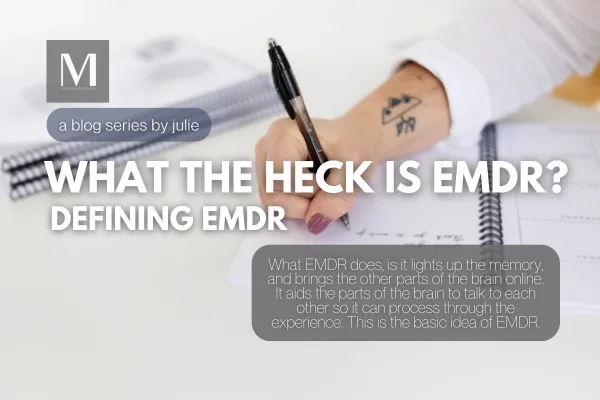the blog
A place for our team to share about topics they are passionate about, in hopes of allowing you to see and understand a bit more behind the faces on these pages.

What the Heck is EMDR? Defining EMDR
We are seeing more and more inquiries about EMDR, so we figured let's talk about it so people actually know what EMDR is and how it works. There’s a personal bias right from the beginning. I’ve been trained in EMDR for the last 10 years, have worked my way to becoming an EMDRIA Approved Consultant and have done thousands upon thousands of hours of EMDR over the years. I believe in this approach so much that most of the MCC team is also trained in it, so we can offer it to all clients if they want it. That’s how much I believe in this approach. That being said, I, and we at MCC, are not purists meaning that we only abide by one type of therapeutic approach. There are lots of different approaches and they all work well for different things. We will always use the approach that works best for you, whether that’s EMDR or something else.
EMDR stands for Eye Movement Desensitization and Reprocessing. It originated more than 30 years ago and the research body has grown exponentially since then. EMDR is based on the idea that bilateral movements (originally eye movements) help your brain access and process information that may be traumatic or distressing. EMDR originally used eye movements where your eyes would go back and forth, similar to what happens in REM sleep. Over the years through more research and creativity, the bilateral movements expanded and now include a variety of movements, and is not just based on eye movements. We often use bilateral movements such as audible beeps which are sounds that go back and forth in your ears, tapping on either side of the body, pulsers that you hold and they vibrate back and forth in your hands, stomping, colouring, drumming and many others only limited by creativity.
What happens when we experience a trauma is that our body, brain and emotions take a picture. This picture is with all five of our senses, our emotions, and often a negative belief. If we don’t process this experience usually within 24-72 hours then we put it away in a filing cabinet in our brain. What happens though, is that this filing cabinet doesn’t just stay closed. When we get triggered or something sparks one of those memories, sensations, or emotions the filing cabinet can fling open. When it flings open often times we can have an increase in anxiety, intrusive thoughts, panic attacks, flashbacks, nightmares or a variety of other symptoms. It shuts down part of our brain and the other part of our brain where those things are stored hijack the rest of our brain so we can't talk ourselves through it until we’ve calmed down enough to be able to start to think in the present again.
What EMDR does, is it lights up the memory, and brings the other parts of the brain online. It aids the parts of the brain to talk to each other so it can process through the experience. This is the basic idea of EMDR. If you want more information, there is lots on the EMDRIA website which is the official website for EMDR.
Stay tuned for the next blog to learn how we set up for EMDR sessions.
Office Location: 1200 Brock Street South, Whitby, ON. L1N 4L9
© Marquis Counselling & Consulting | ALL RIGHTS RESERVED | TERMS & CONDITIONS | PRIVACY POLICY

